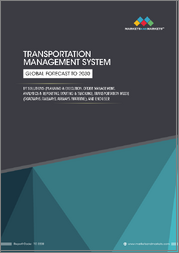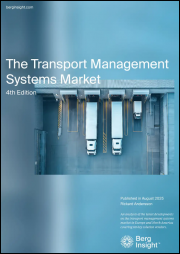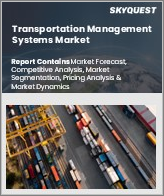
|
시장보고서
상품코드
1782742
세계의 운송 관리 시스템 시장 조사 보고서 : 산업 분석, 규모, 점유율, 성장, 동향, 예측(2025-2033년)Global Transportation Management Systems Market Research Report- Industry Analysis, Size, Share, Growth, Trends and Forecast 2025 to 2033 |
||||||
세계의 운송 관리 시스템 시장 규모는 2024년 156억 8,000만 달러에서 2033년에는 680억 6,000만 달러로 성장하여 2026년부터 2033년까지 예측 기간 동안 17.72%의 견조한 연평균 성장률(CAGR)을 나타낼 것으로 예측됩니다.
운송 관리 시스템(TMS) 시장은 기업이 물류 및 공급망 운영을 관리하기 위한 효율적인 솔루션을 찾는 경향이 강화되면서 큰 폭의 성장이 예상됩니다. TMS 소프트웨어는 기업이 운송 프로세스를 최적화하고, 가시성을 개선하며, 운송 및 화물 관리와 관련된 비용을 절감할 수 있도록 도와줍니다. E-Commerce와 세계 무역의 확대로 인해 간소화된 물류 솔루션에 대한 수요가 증가함에 따라 운송 관리 시스템 시장은 더욱 확대될 것으로 예상됩니다. 이러한 추세는 효율적인 운송 관리가 업무의 성공에 필수적인 소매, 제조, 물류 등의 산업에서 특히 두드러집니다.
또한, 지속가능성과 탄소발자국 감소에 대한 중요성이 강조되고 있는 것도 TMS 시장에 큰 영향을 미치고 있습니다. 기업이 환경 친화적인 활동을 우선시하는 가운데, 운송 경로의 최적화, 연료 소비 감소, 배출량 최소화를 지원하는 운송 관리 시스템에 대한 수요가 증가하고 있습니다. 개발업체들은 효율성과 지속가능성을 높이는 고급 분석 및 최적화 알고리즘을 통합한 TMS 솔루션을 개발하여 대응하고 있습니다. 기업이 소비자의 가치와 규제 요건에 부합하기 위해 노력함에 따라 보다 친환경적인 물류 솔루션으로의 전환은 운송 관리 시스템 시장을 촉진할 것으로 예상됩니다.
또한, 기술의 발전으로 운송 관리 시스템의 기능이 강화되고 있습니다. 클라우드 컴퓨팅, 인공지능(AI), 사물인터넷(IoT)의 혁신은 TMS 솔루션의 기능성과 접근성을 향상시키고, 실시간 추적 및 데이터 기반 의사결정을 가능하게 합니다. 또한, TMS를 다른 공급망 관리 도구와 통합하여 비즈니스에 더 높은 수준의 효율성과 협업을 제공합니다. 운송 관리 시스템 시장이 이러한 트렌드와 기술 발전을 계속 수용함에 따라 지속적인 성장이 예상되며, 물류 및 공급망 산업의 주요 기업으로서의 입지를 확고히 할 것으로 보입니다.
이 보고서는 다양한 산업과 시장에 대한 포괄적이고 실용적인 인사이트를 제공할 수 있도록 세심하게 작성되었습니다. 각 보고서는 시장 상황을 완전히 이해하기 위해 몇 가지 중요한 요소를 포함하고 있습니다:
시장 개요 : 정의, 분류, 산업 현황 등 시장에 대한 자세한 소개.
시장 역학 : 시장 성장에 영향을 미치는 주요 촉진요인, 억제요인, 기회 및 과제를 상세히 분석합니다. 이 섹션에서는 기술 발전, 규제 변화, 새로운 트렌드 등의 요인을 살펴봅니다.
세분화 분석 : 제품 유형, 용도, 최종사용자, 지역 등의 기준에 따라 시장을 명확한 부문으로 세분화합니다. 이 분석을 통해 각 부문의 실적과 미래성을 파악할 수 있습니다.
경쟁 상황 : 시장 점유율, 제품 포트폴리오, 전략적 이니셔티브, 재무 실적 등 주요 시장 플레이어에 대한 종합적인 평가. 주요 기업들이 채택하고 있는 경쟁 역학 및 주요 전략에 대한 인사이트를 제공합니다.
시장 예측 : 과거 데이터와 현재 시장 상황을 바탕으로 일정 기간의 시장 규모와 성장 추세를 예측합니다. 여기에는 정량적 분석과 향후 시장 궤적을 보여주는 그래프 표시가 포함됩니다.
지역별 분석 : 지역별 시장 성과를 평가하고 주요 시장 및 지역 동향을 파악합니다. 지역 시장 역학 및 비즈니스 기회를 이해하는 데 도움이 됩니다.
새로운 트렌드와 기회 : 현재 시장 동향과 새로운 시장 동향, 기술 혁신, 잠재적 투자 대상 분야를 파악합니다. 향후 시장 개척과 성장 전망에 대한 인사이트를 제공합니다.
목차
제1장 서문
제2장 주요 요약
- 시장 하이라이트
- 세계 시장 현황
제3장 운송 관리 시스템 산업 분석
- 소개 : 시장 역학
- 시장 성장 촉진요인
- 시장 성장 억제요인
- 기회
- 업계 동향
- Porter's Five Forces 분석
- 시장 매력 분석
제4장 밸류체인 분석
- 밸류체인 분석
- 원재료 분석
- 원재료 리스트
- 원재료 제조업체 리스트
- 주요 원재료 가격 동향
- 잠재적 바이어 리스트
- 마케팅 채널
- 직접 마케팅
- 간접 마케팅
- 마케팅 채널 발전 동향
제5장 운송 관리 시스템 세계 시장 분석 : 제공별
- 제공별 개요
- 제공별 과거·예측 데이터 분석
- 솔루션
- 서비스
제6장 운송 관리 시스템 세계 시장 분석 : 운송 수단별
- 운송 수단별 개요
- 운송 수단별 과거·예측 데이터 분석
- 도로
- 철도
- 항공
- 해운
제7장 운송 관리 시스템 세계 시장 분석 : 조직 규모별
- 조직 규모별 개요
- 조직 규모별 과거·예측 데이터 분석
- 중소기업
- 대기업
제8장 운송 관리 시스템 세계 시장 분석 : 전개별
- 전개별 개요
- 전개별 과거·예측 데이터 분석
- 온프레미스
- 클라우드
제9장 운송 관리 시스템 세계 시장 분석 : 최종 이용 산업별
- 최종 이용 산업별 개요
- 최종 이용 산업별 과거·예측 데이터 분석
- 헬스케어 및 의약품
- 제조업
- 광업
- 자동차
- 에너지·유틸리티
- 소매·E-Commerce
- 식품 및 음료
- 기타
제10장 운송 관리 시스템 세계 시장 분석 : 지역별
- 지역별 전망
- 소개
- 북미 매출 분석
- 개요, 실적과 예측
- 북미 : 부문별
- 북미 국가별
- 미국
- 캐나다
- 멕시코
- 유럽 매출 분석
- 개요, 실적과 예측
- 유럽 부문별
- 유럽 국가별
- 영국
- 프랑스
- 독일
- 이탈리아
- 러시아
- 기타 유럽
- 아시아태평양 매출 분석
- 개요, 실적과 예측
- 아시아태평양 부문별
- 아시아태평양 국가별
- 중국
- 인도
- 일본
- 한국
- 호주
- 동남아시아
- 기타 아시아태평양
- 라틴아메리카 매출 분석
- 개요, 실적과 예측
- 라틴아메리카 부문별
- 라틴아메리카 국가별
- 브라질
- 아르헨티나
- 페루
- 칠레
- 기타 라틴아메리카
- 중동 및 아프리카 매출 분석
- 개요, 실적과 예측
- 중동 및 아프리카 부문별
- 중동 및 아프리카 국가별 리스트
- 사우디아라비아
- 아랍에미리트
- 이스라엘
- 남아프리카공화국
- 기타 중동 및 아프리카
제11장 운송 관리 시스템 기업 경쟁 구도
- 운송 관리 시스템 시장 경쟁
- 제휴, 협력, 합의
- 인수합병
- 신제품 발매
- 기타 개발
제12장 기업 개요
- 상위 기업의 시장 점유율 분석
- 시장 집중도
- Oracle Corporation
- SAP SE
- C.H. Robinson
- Descartes Systems Group
- Blue Yonder
- Inlet-Logistics
- Alpega Group
- Blujay Solutions
- MercuryGate International Inc.
- 3T Logistics
Global Transportation Management Systems Market size is anticipated to grow from USD 15.68 Billion in 2024 to USD 68.06 Billion by 2033, showcasing a robust Compound Annual Growth Rate (CAGR) of 17.72% during the forecast period of 2026 to 2033.
The transportation management systems (TMS) market is poised for significant growth as businesses increasingly seek efficient solutions for managing their logistics and supply chain operations. TMS software helps organizations optimize their transportation processes, improve visibility, and reduce costs associated with shipping and freight management. As the demand for streamlined logistics solutions rises, driven by the growth of e-commerce and global trade, the market for transportation management systems is expected to expand further. This trend is particularly evident in industries such as retail, manufacturing, and logistics, where effective transportation management is critical for operational success.
Moreover, the growing emphasis on sustainability and reducing carbon footprints is significantly influencing the TMS market. As companies prioritize environmentally responsible practices, there is a rising demand for transportation management systems that can help optimize routes, reduce fuel consumption, and minimize emissions. Manufacturers are responding by developing TMS solutions that incorporate advanced analytics and optimization algorithms to enhance efficiency and sustainability. This shift towards greener logistics solutions is expected to propel the transportation management systems market, as organizations seek to align with consumer values and regulatory requirements.
Additionally, advancements in technology are enhancing the capabilities of transportation management systems. Innovations in cloud computing, artificial intelligence (AI), and the Internet of Things (IoT) are improving the functionality and accessibility of TMS solutions, enabling real-time tracking and data-driven decision-making. Furthermore, the integration of TMS with other supply chain management tools is providing additional levels of efficiency and collaboration for businesses. As the transportation management systems market continues to embrace these trends and technological advancements, it is expected to experience sustained growth, solidifying its position as a key player in the logistics and supply chain industry.
Our reports are meticulously crafted to provide clients with comprehensive and actionable insights into various industries and markets. Each report encompasses several critical components to ensure a thorough understanding of the market landscape:
Market Overview: A detailed introduction to the market, including definitions, classifications, and an overview of the industry's current state.
Market Dynamics: In-depth analysis of key drivers, restraints, opportunities, and challenges influencing market growth. This section examines factors such as technological advancements, regulatory changes, and emerging trends.
Segmentation Analysis: Breakdown of the market into distinct segments based on criteria like product type, application, end-user, and geography. This analysis highlights the performance and potential of each segment.
Competitive Landscape: Comprehensive assessment of major market players, including their market share, product portfolio, strategic initiatives, and financial performance. This section provides insights into the competitive dynamics and key strategies adopted by leading companies.
Market Forecast: Projections of market size and growth trends over a specified period, based on historical data and current market conditions. This includes quantitative analyses and graphical representations to illustrate future market trajectories.
Regional Analysis: Evaluation of market performance across different geographical regions, identifying key markets and regional trends. This helps in understanding regional market dynamics and opportunities.
Emerging Trends and Opportunities: Identification of current and emerging market trends, technological innovations, and potential areas for investment. This section offers insights into future market developments and growth prospects.
SEGMENTATION COVERED IN THE REPORT
By Offering
- Solution
- Services
By Transportation Mode
- Roadways
- Railways
- Airways
- Maritime
By Organization Size
- Small & Medium Enterprises
- Large Enterprises
By Deployment
- On Premise
- Cloud
By End Use Industry
- Healthcare & Pharmaceuticals
- Manufacturing
- Mining
- Automotive
- Energy & Utilities
- Retail & E-commerce
- Food & Beverage
- Others
- COMPANIES PROFILED
- Oracle Corporation
- SAP SE
- C.H. Robinson
- Descartes Systems Group
- Blue Yonder
- Inlet-Logistics
- Alpega Group
- Blujay Solutions
- MercuryGate International Inc.
- 3T Logistics
- The above list can be customized.
TABLE OF CONTENTS
1. PREFACE
- 1.1. Report Description
- 1.1.1 Objective
- 1.1.2 Target Audience
- 1.1.3 Unique Selling Proposition (USP) & offerings
- 1.2. Research Scope
- 1.3. Research Methodology
- 1.3.1 Market Research Process
- 1.3.2 Market Research Methodology
2. EXECUTIVE SUMMARY
- 2.1. Highlights of Market
- 2.2. Global Market Snapshot
3. TRANSPORTATION MANAGEMENT SYSTEMS INDUSTRY ANALYSIS
- 3.1. Introduction - Market Dynamics
- 3.2. Market Drivers
- 3.3. Market Restraints
- 3.4. Opportunities
- 3.5. Industry Trends
- 3.6. Porter's Five Force Analysis
- 3.7. Market Attractiveness Analysis
- 3.7.1 Market Attractiveness Analysis By Offering
- 3.7.2 Market Attractiveness Analysis By Transportation Mode
- 3.7.3 Market Attractiveness Analysis By Organization Size
- 3.7.4 Market Attractiveness Analysis By Deployment
- 3.7.5 Market Attractiveness Analysis By End Use Industry
- 3.7.6 Market Attractiveness Analysis By Regions
4. VALUE CHAIN ANALYSIS
- 4.1. Value Chain Analysis
- 4.2. Raw Material Analysis
- 4.2.1 List of Raw Materials
- 4.2.2 Raw Material Manufactures List
- 4.2.3 Price Trend of Key Raw Materials
- 4.3. List of Potential Buyers
- 4.4. Marketing Channel
- 4.4.1 Direct Marketing
- 4.4.2 Indirect Marketing
- 4.4.3 Marketing Channel Development Trend
5. GLOBAL TRANSPORTATION MANAGEMENT SYSTEMS MARKET ANALYSIS BY OFFERING
- 5.1. Overview By Offering
- 5.2. Historical and Forecast Data Analysis By Offering
- 5.3. Solution Historic and Forecast Sales By Regions
- 5.4. Services Historic and Forecast Sales By Regions
6. GLOBAL TRANSPORTATION MANAGEMENT SYSTEMS MARKET ANALYSIS BY TRANSPORTATION MODE
- 6.1. Overview By Transportation Mode
- 6.2. Historical and Forecast Data Analysis By Transportation Mode
- 6.3. Roadways Historic and Forecast Sales By Regions
- 6.4. Railways Historic and Forecast Sales By Regions
- 6.5. Airways Historic and Forecast Sales By Regions
- 6.6. Maritime Historic and Forecast Sales By Regions
7. GLOBAL TRANSPORTATION MANAGEMENT SYSTEMS MARKET ANALYSIS BY ORGANIZATION SIZE
- 7.1. Overview By Organization Size
- 7.2. Historical and Forecast Data Analysis By Organization Size
- 7.3. Small & Medium Enterprises Historic and Forecast Sales By Regions
- 7.4. Large Enterprises Historic and Forecast Sales By Regions
8. GLOBAL TRANSPORTATION MANAGEMENT SYSTEMS MARKET ANALYSIS BY DEPLOYMENT
- 8.1. Overview By Deployment
- 8.2. Historical and Forecast Data Analysis By Deployment
- 8.3. On Premise Historic and Forecast Sales By Regions
- 8.4. Cloud Historic and Forecast Sales By Regions
9. GLOBAL TRANSPORTATION MANAGEMENT SYSTEMS MARKET ANALYSIS BY END USE INDUSTRY
- 9.1. Overview By End Use Industry
- 9.2. Historical and Forecast Data Analysis By End Use Industry
- 9.3. Healthcare & Pharmaceuticals Historic and Forecast Sales By Regions
- 9.4. Manufacturing Historic and Forecast Sales By Regions
- 9.5. Mining Historic and Forecast Sales By Regions
- 9.6. Automotive Historic and Forecast Sales By Regions
- 9.7. Energy & Utilities Historic and Forecast Sales By Regions
- 9.8. Retail & E-commerce Historic and Forecast Sales By Regions
- 9.9. Food & Beverage Historic and Forecast Sales By Regions
- 9.10. Others Historic and Forecast Sales By Regions
10. GLOBAL TRANSPORTATION MANAGEMENT SYSTEMS MARKET ANALYSIS BY GEOGRAPHY
- 10.1. Regional Outlook
- 10.2. Introduction
- 10.3. North America Sales Analysis
- 10.3.1 Overview, Historic and Forecast Data Sales Analysis
- 10.3.2 North America By Segment Sales Analysis
- 10.3.3 North America By Country Sales Analysis
- 10.3.4 United States Sales Analysis
- 10.3.5 Canada Sales Analysis
- 10.3.6 Mexico Sales Analysis
- 10.4. Europe Sales Analysis
- 10.4.1 Overview, Historic and Forecast Data Sales Analysis
- 10.4.2 Europe By Segment Sales Analysis
- 10.4.3 Europe By Country Sales Analysis
- 10.4.4 United Kingdom Sales Analysis
- 10.4.5 France Sales Analysis
- 10.4.6 Germany Sales Analysis
- 10.4.7 Italy Sales Analysis
- 10.4.8 Russia Sales Analysis
- 10.4.9 Rest Of Europe Sales Analysis
- 10.5. Asia Pacific Sales Analysis
- 10.5.1 Overview, Historic and Forecast Data Sales Analysis
- 10.5.2 Asia Pacific By Segment Sales Analysis
- 10.5.3 Asia Pacific By Country Sales Analysis
- 10.5.4 China Sales Analysis
- 10.5.5 India Sales Analysis
- 10.5.6 Japan Sales Analysis
- 10.5.7 South Korea Sales Analysis
- 10.5.8 Australia Sales Analysis
- 10.5.9 South East Asia Sales Analysis
- 10.5.10 Rest Of Asia Pacific Sales Analysis
- 10.6. Latin America Sales Analysis
- 10.6.1 Overview, Historic and Forecast Data Sales Analysis
- 10.6.2 Latin America By Segment Sales Analysis
- 10.6.3 Latin America By Country Sales Analysis
- 10.6.4 Brazil Sales Analysis
- 10.6.5 Argentina Sales Analysis
- 10.6.6 Peru Sales Analysis
- 10.6.7 Chile Sales Analysis
- 10.6.8 Rest of Latin America Sales Analysis
- 10.7. Middle East & Africa Sales Analysis
- 10.7.1 Overview, Historic and Forecast Data Sales Analysis
- 10.7.2 Middle East & Africa By Segment Sales Analysis
- 10.7.3 Middle East & Africa By Country Sales Analysis
- 10.7.4 Saudi Arabia Sales Analysis
- 10.7.5 UAE Sales Analysis
- 10.7.6 Israel Sales Analysis
- 10.7.7 South Africa Sales Analysis
- 10.7.8 Rest Of Middle East And Africa Sales Analysis
11. COMPETITIVE LANDSCAPE OF THE TRANSPORTATION MANAGEMENT SYSTEMS COMPANIES
- 11.1. Transportation Management Systems Market Competition
- 11.2. Partnership/Collaboration/Agreement
- 11.3. Merger And Acquisitions
- 11.4. New Product Launch
- 11.5. Other Developments
12. COMPANY PROFILES OF TRANSPORTATION MANAGEMENT SYSTEMS INDUSTRY
- 12.1. Top Companies Market Share Analysis
- 12.2. Market Concentration Rate
- 12.3. Oracle Corporation
- 12.3.1 Company Overview
- 12.3.2 Company Revenue
- 12.3.3 Products
- 12.3.4 Recent Developments
- 12.4. SAP SE
- 12.4.1 Company Overview
- 12.4.2 Company Revenue
- 12.4.3 Products
- 12.4.4 Recent Developments
- 12.5. C.H. Robinson
- 12.5.1 Company Overview
- 12.5.2 Company Revenue
- 12.5.3 Products
- 12.5.4 Recent Developments
- 12.6. Descartes Systems Group
- 12.6.1 Company Overview
- 12.6.2 Company Revenue
- 12.6.3 Products
- 12.6.4 Recent Developments
- 12.7. Blue Yonder
- 12.7.1 Company Overview
- 12.7.2 Company Revenue
- 12.7.3 Products
- 12.7.4 Recent Developments
- 12.8. Inlet-Logistics
- 12.8.1 Company Overview
- 12.8.2 Company Revenue
- 12.8.3 Products
- 12.8.4 Recent Developments
- 12.9. Alpega Group
- 12.9.1 Company Overview
- 12.9.2 Company Revenue
- 12.9.3 Products
- 12.9.4 Recent Developments
- 12.10. Blujay Solutions
- 12.10.1 Company Overview
- 12.10.2 Company Revenue
- 12.10.3 Products
- 12.10.4 Recent Developments
- 12.11. MercuryGate International Inc.
- 12.11.1 Company Overview
- 12.11.2 Company Revenue
- 12.11.3 Products
- 12.11.4 Recent Developments
- 12.12. 3T Logistics
- 12.12.1 Company Overview
- 12.12.2 Company Revenue
- 12.12.3 Products
- 12.12.4 Recent Developments



















